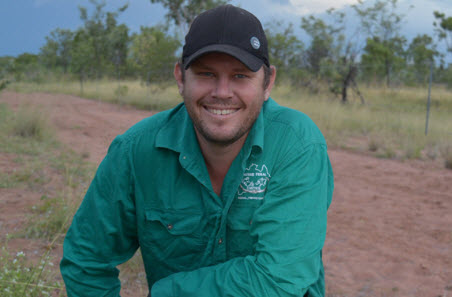Taking control of stock losses

If it’s feral, got four legs and lives in the Northern Territory, there’s a big chance Adam Bowen has trapped, baited or shot it.
The professional contract pest controller, based in Katherine, has had cats, pigs, buffalo, camels and donkeys on his hit list, but the most requested service by far is to reduce the impact of wild dogs on livestock.
“I usually travel more than 30,000 km a year, from the Queensland border to Adelaide River. Since cattle prices have risen, more pastoralists are taking stock of what they’re losing and are investing in good control programs,” Adam said.
Adam works both ends of the pastoral spectrum: from the NAPCO-owned Alexandria Station on the Barkly Tablelands, Australia’s second largest pastoral property, to hobby blocks on the edge of Katherine. Adam said last year he trapped 26 dogs on a 405ha cattle stud in just six weeks.
His tools of the trade vary; however, baiting with 1080 is his weapon of choice.
“In a normal year I would put out between 30,000 and 45,000 baits, usually in May/June and then again in September, October or even November, depending on the rains,” he said.
“I like to have baits in place as protection for when the earliest cows start calving, particularly if the dry has been tough.
“In places such as the Barkly region, there are not a lot of other target species for dogs so a young calf is easy pickings.”
Finding the right tools
With such a variation in location and terrain, Adam uses a suite of tools to reduce dog numbers.
“On the larger places, where watering points are really spread out, trapping is not a humane option,” he said.
“The NT has not approved the use of lethal trap devices (where traps are laced with strychnine ensuring animals are not left to suffer), so that leaves only on-ground and aerial 1080 baiting.”
Adam has started using the relatively new canid pest ejector, a spring-activated device that ejects the 1080 from a capsule into the dog’s mouth when it pulls on a bait head.
He said these devices were growing in popularity as pastoralists saw the value of being able to bait close to houses and in laneways, where station dogs and pets might be at risk.
The devices are pegged into the ground and can’t be moved, so the 1080 will stay where it is placed. Another benefit is that carrion consumers like goannas and eagles can’t steal the baits, so the ejector device is always ready to go when a dog comes along.
“On one station we have pest ejectors set down a laneway,” Adam said.
“When cattle need to be moved through, each ejector is covered with an old plough disc.
“Once the cattle and station dogs have passed, the discs are removed and the traps are reactivated.
“The pest ejectors are also popular with my clients close to town because of the reduced off-target risk and, because the ejector is fixed, an animal can’t take the bait away and store it to eat later.”
Information: Adam Bowen E: aussieferalcontrol@hotmail.com
Resources
- www.invasiveanimals.com
- The Glovebox Guide for Managing Wild Dogs: www.pestsmart.org.au/pestsmart-glovebox-guide-for-managing-wild-dogs/
- Wild Dog Scan – a free tool that maps and records wild dog activity Australia-wide: www.feralscan.org.au/wilddogscan/map.aspx
- Canid pest ejector demo: http://www.pestsmart.org.au/canid-pest-ejector-cpe-fox-wild-dog-control/



